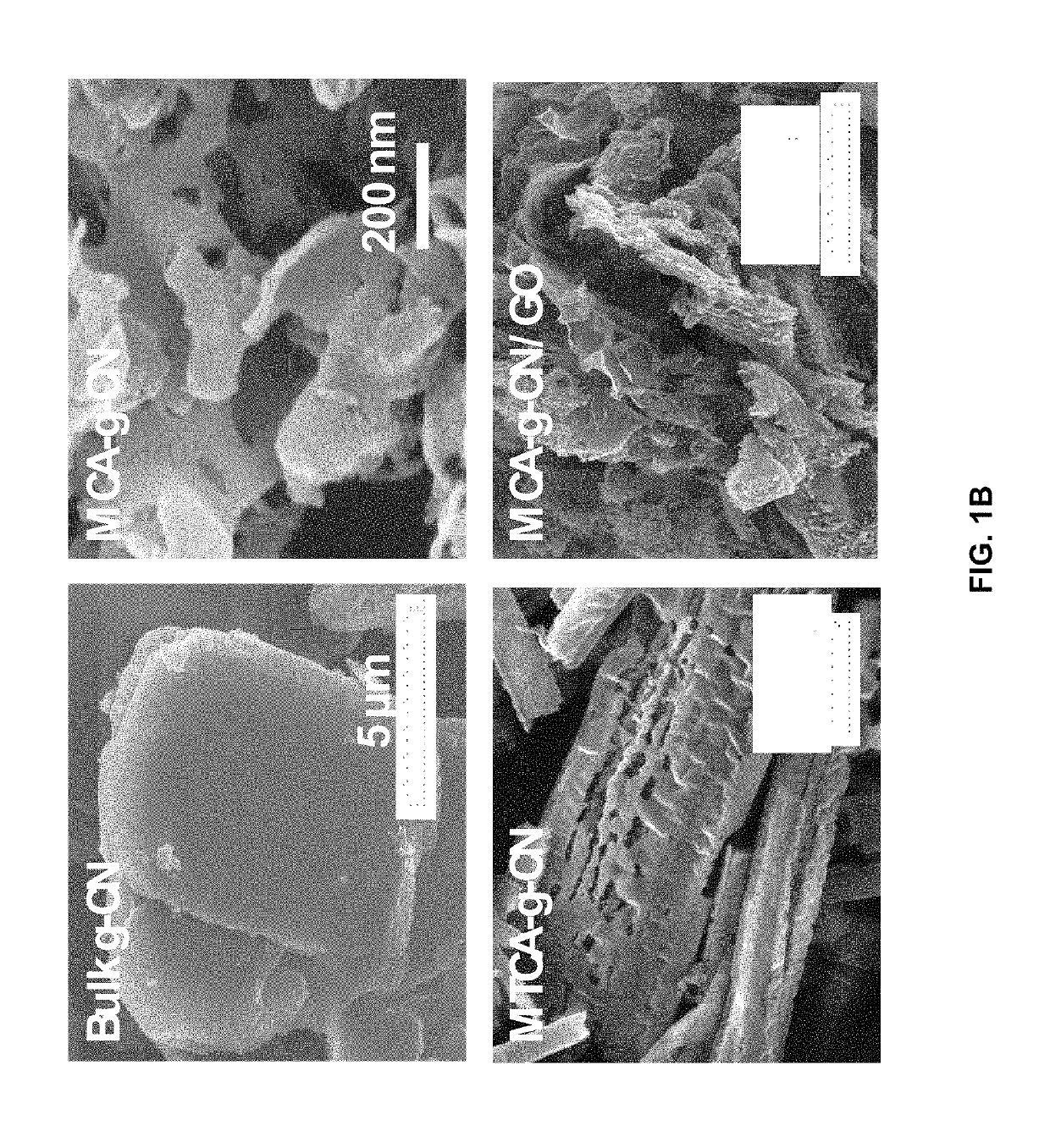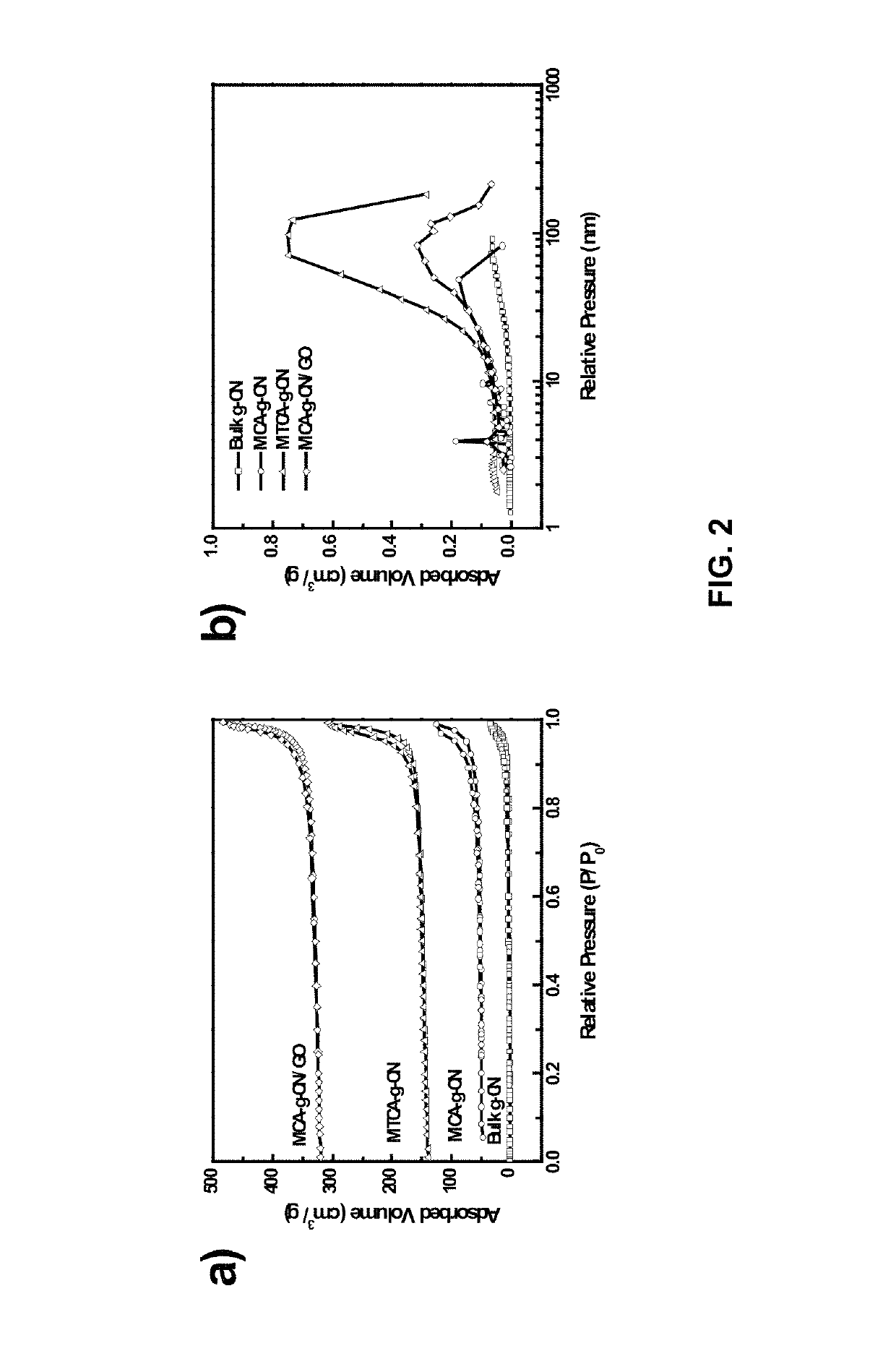Pnictide containing catalysts for electrochemical conversion reactions and methods of use
a catalyst and pnictide technology, applied in the field of methods and materials useful with electrochemical cell systems, can solve the problems of not being able to meet the energy density requirements of many emerging applications, the advancement of li/s battery technology has not been as rapid, and the li/s system has not been adapted for high-power applications, etc., to achieve the effect of reducing the resistance of electrode charge transfer, increasing the electrode kinetics, and reducing the resistance of electrode charg
- Summary
- Abstract
- Description
- Claims
- Application Information
AI Technical Summary
Benefits of technology
Problems solved by technology
Method used
Image
Examples
example 1
Rich Tri-S-Triazine Based Graphitic Carbon Nitride (G-Cn) as a Heterogeneous Catalyst
[0066]Sulfur-amine solution was employed as a inexpensive, less-hazardous sulfur precursor to synthesize metal sulfide nanocrystals.[6] Ammonium polysulfides generate H2S and intermediate species such as thioamide and amidine in the presence of excess amine at high temperatures (˜130° C.). These sulfur species react with metal precursors to give the corresponding metal sulfides. Very recently, it was also shown that sulfur-amine solution enables the uniform deposition of sulfur onto the carbon nanostructure at a low temperature in a scalable manner[7] Ammonium polysulfides precipitates on the multi-walled carbon nanotube (MWNT) as a thin layer with a thickness of 6˜7 nm simply by addition of diluted hydrochloric acids.
[0067]Of particular interest in amine-sulfur chemistry is that 1) the amine-sulfur complex helps to retain the linear polysulfides in the cathode structure via chemical bonding and 2) ...
example 2
ive Electrochemical Cell Materials
[0069]Electrochemical Cell Materials: Consisted of standard ½″ Swagelock™ type cells, utilized for basic electrochemical benchmarking, a common strategy known to practitioners in the art. All materials consisted of 316 stainless steel, polyimide film as the insulating sleeve, nylon ferrules and Whatman GF / D nonwoven glass fiber as the separator.
[0070]Electrolyte: Lithium polysulfide catholyte solutions (Li2S8 if not otherwise specified) were prepared by mixing stoichiometric amounts of Li metal (Alfa Aesar) and sulfur powder (99.99% Strem Chemical) in tetraethyleneglycol dimethyl ether (Acros Organics, fractionally vacuum distilled over mol sieves upon receipt), at 5 m. with respect to Li, and heated between 90-100° C. for several days or until all solids were dissolved. A working catholyte solution was prepared by diluting the concentrated lithium polysulfide solution with tetraethylene sulfone (Acros Organics, fractionally vacuum distilled over mo...
example 3
CN in Electrochemical Cells
[0073]The electrocatalytic activity of g-CN was first tested in heterogeneous system containing a catholyte. Following comparative example 2 protocol, two distinct Swagelock™ type cells where constructed; one having 25 wt % g-CN-2 / 75 wt % Super P and the other having 25 wt % g-CN-4 / 75 wt % Super P. g-CN was disposed in the conductive carbon by milling in a mortar / pastel for 15 minutes (b) 25 wt % g-CN-2 / 75 wt % Super P and (c) 25 wt % g-CN-4 / 75 wt % Super P. Cyclic voltammetry (CV) measurements were performed in the potential range 1.0˜3.2 V vs. Li / Li shown as traces (b) and (c) respectively in FIG. 3.
[0074]The Super P and g-CN-2 / Super P show nearly the same CV profiles at a slow scan rate (0.1 mVs−1) with the exception that the second reduction peak of g-CN-2 / Super P appears at a potential slightly higher than that of Super P (FIG. 3, top). The cathodic current observed around 1 V vs. Li / Li+ results from the overpotential due to the strain / stress induced ...
PUM
| Property | Measurement | Unit |
|---|---|---|
| conductivity | aaaaa | aaaaa |
| diameter | aaaaa | aaaaa |
| diameter | aaaaa | aaaaa |
Abstract
Description
Claims
Application Information
 Login to View More
Login to View More - R&D
- Intellectual Property
- Life Sciences
- Materials
- Tech Scout
- Unparalleled Data Quality
- Higher Quality Content
- 60% Fewer Hallucinations
Browse by: Latest US Patents, China's latest patents, Technical Efficacy Thesaurus, Application Domain, Technology Topic, Popular Technical Reports.
© 2025 PatSnap. All rights reserved.Legal|Privacy policy|Modern Slavery Act Transparency Statement|Sitemap|About US| Contact US: help@patsnap.com



